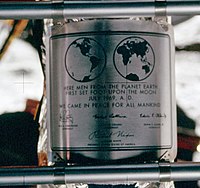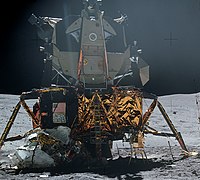


Lunar plaques are stainless steel commemorative plaques measuring 9 by 7+5⁄8 inches (22.9 by 19.4 cm) attached to the ladders on the descent stages of the United States Apollo Lunar Modules flown on lunar landing missions Apollo 11 through Apollo 17, to be left permanently on the lunar surface. The plaques were originally suggested and designed by NASA's head of technical services Jack Kinzler, who oversaw their production.[2]
All of the plaques bear facsimiles of the participating astronauts' signatures. For this reason, an extra plaque had to be made for Apollo 13 due to the late replacement of one crew member. The first (Apollo 11) and last (Apollo 17) plaques bear a facsimile of the signature of Richard Nixon, President of the United States during the landings, along with references to the start and completion of "man's first explorations of the Moon" and expressions of peace "for all mankind".
All, except the Apollo 12 plaque (which is also textured differently), bear pictures of the two hemispheres of Earth. Apollo 17's plaque bears a depiction of the lunar globe in addition to the Earth. The plaques used on missions 13 through 16 bear the call-sign of each mission's Lunar Module. All of the plaques were left on the Moon, except for those of the aborted Apollo 13 mission.

This article includes a list of general references, but it lacks sufficient corresponding inline citations. Please help to improve this article by introducing more precise citations. (August 2023) (Learn how and when to remove this message)
|
|
| |
|---|---|
| Launch vehicles |
|
| Launch vehicle components |
|
| Spacecraft |
|
| Spacecraft components |
|
| Space suits |
|
| Lunar surface equipment |
|
| Ground support |
|
| Ceremonial |
|
| Related |
|